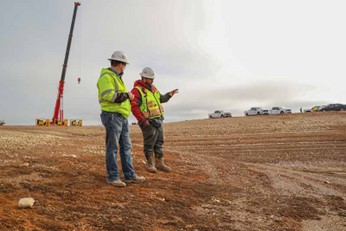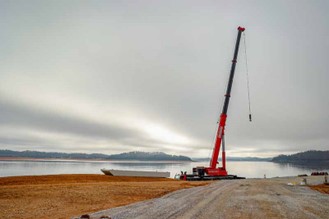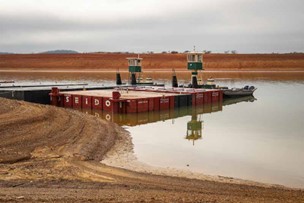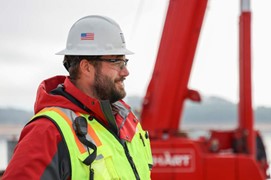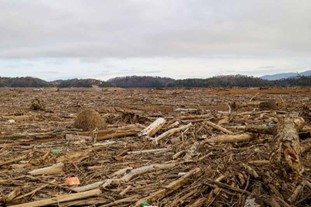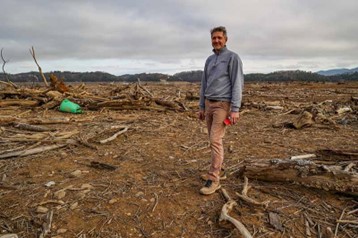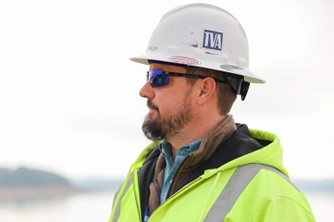Feb 19, 2025
Multiagency Debris Removal Effort Underway at Douglas Reservoir
On a steel-gray winter afternoon in east Tennessee, the sun sliced through clouds to cast Douglas Reservoir’s drawn-down shores in gold.
Skid-steer loaders beeped and zoomed across the bare earth in the distance. They carried load after load of logs, unceasing as they built a high pile of wood.
“The big 320, from this distance, looks small,” Alex McClain, Tennessee Valley Authority field supervisor, said, nodding toward the zooming loaders. “But it’s a 60,000-pound machine, and it can go anywhere.”
McClain would know.
He and Clint Stanley, TVA civil construction project and field support manager, were coordinating a multiagency flood recovery project funded by state and federal emergency management agencies to help the area after Hurricane Helene.
Stanley explained that it’s unusual for TVA to take part in debris cleanups. TVA became a key partner because of its relationships with the community, its already-established maintenance rights of way and to preserve dam safety.
“This is a once-in-a-lifetime, once-in-a-generation kind of storm event that has caused devastation here,” Stanley said. “We’re proud to be part of the solution. We’re proud to be partners with all the other agencies.”
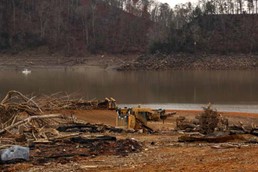
Multiple agencies have teamed up to remove debris from Douglas Reservoir. (Photos by Susan Ehrenclou / TVA)
Debris Cleanup
At the site with the thickest debris – known as 13R, because it’s at river mile 13 on the right – McClain surveyed debris that had settled onto wide reservoir shores after winter water drawdown.
Homeowner and local business owner Robert Delventhal waved and picked his way through the piles to greet McClain.
“It was just eerie in the beginning,” Delventhal said. “You think about what others are going through.”
“There are a lot of people who lost a lot,” McClain agreed. “There’s a whole top to a log structure over there. That hit me hard – that was somebody’s workshop, maybe.”
Delventhal said that, at first, he hopped on his skid-steer loader to help. Other homeowners had the same impulse to do anything they could.
“We pushed some stuff around so that when TVA got here, it was away from the dock. But it was just overwhelming,” Delventhal said. “It was scary to walk through. And you guys have been watching it every day.”
Sorting it out
TVA and its partners were watching – and working.
“We’re deploying barges, push boats, equipment, people,” Stanley said. “We’ve developed a zone map of our primary areas of concern and, within that, we have prioritized based on quantities – magnitude of impact as well as the commercial and marine impacts going into spring.”
Multiagency cleanup efforts in Douglas Reservoir began in the weeks following Hurricane Helene in fall 2024 and will continue until the job is done.
“It’s thousands of cubic yards,” McClain said. “We’re at winter pool – they’ve dropped the lake 30-some feet, and the debris is on the banks now.”
Dealing properly with the debris matters to many stakeholders – agencies and communities that depend on the dams, reservoirs and river system.
Cleanup means hauling, pushing, carrying and carefully sorting debris.
McClain explained contractors hauled clean wood – trees, logs and untreated water-logged lumber – straight to permitted burn sites far from homes.
Other partners dealt with everything else – treated wood, telephone poles, railroad ties, plastics, shingles, metal. Those items went to a landfill for safe disposal.
On shorelines harder to access by road, barges would carry debris, 450 cubic yards at a time, back to centralized burn or pickup sites.
“We’re going to hit what we can in accessible areas,” Stanley said. “We’ll use the water rise in the spring to our advantage in those other areas. We’ll have to.”
Quantifying the Cleanup
A common question for Stanley and McClain is how long it will take to clean all the debris.
The answer is complicated.
“Quantifying debris laying on the shoreline over hundreds and hundreds and hundreds of acres is not an easy feat,” Stanley said.
“The scale of it, honestly, it’s hard to explain,” McClain agreed.
Flyovers helped the team estimate the scope and timeline – approximately eight months – of cleanup.
Contractors had already cleaned entire coves in just a few days’ time each, despite heavy rains that turned shores to thick sticky mud.
In one cleaned cove, neat piles of logs and brush awaited hauling to the burn pile, while twisted metal and plastic were ready to be trucked away.
“It takes skilled operators to tease the brush out without damaging docks,” McClain said. “The contractors make a log bridge so the machine’s tracks don’t sink all the way in. They’ve done a wonderful job.”
As cleanup continues, TVA communicates with the public, including sharing zone maps for cleanup sites.
“We’re working as fast as we can, as safely as we can, and it might take a little while to get to areas that haven’t been as negatively affected as others,” Stanley said. “But we’re coming.”
For their part, local residents have been helpful.
McClain said they’ve brought snacks to worksites as thanks, and many gladly offer driveways or private roads for access to coves for cleanup.
“It’s been very positive,” McClain said.
Delventhal agreed.
“I think it’s been going great,” he said. “We appreciate it. I mean, I don’t know what we’d do without you all.”
Photo Gallery
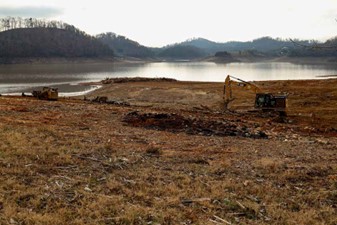
Local, state and federal agencies are coordinating efforts to remove thousands of cubic yards of debris.
Project Partners
The Douglas Reservoir debris removal project is a collaborative effort among local, state and federal agencies working together to clear debris, safeguard downstream infrastructure and restore safe, accessible conditions for the community.
In addition to TVA, agency partners include the Federal Emergency Management Agency, Army Corps of Engineers, Environmental Protection Agency, Occupational Safety and Health Administration, Tennessee Emergency Management Agency, Tennessee Occupational Safety and Health Administration, Tennessee Department of Environment and Conservation and the Tennessee Wildlife Resources Agency. Jefferson County, Tennessee, is also supporting efforts.

